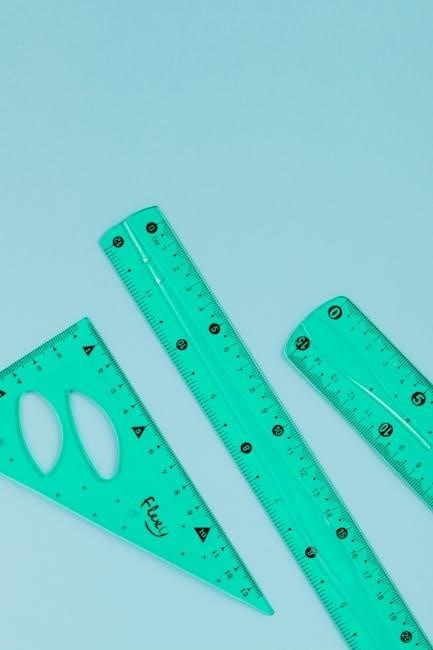Overview of Metric System
The metric system is a decimal-based system of measurement that has been adopted by most countries around the world․ It is used to express quantities such as length, area, volume, and mass․ The metric system is based on seven fundamental units, which are used to derive all other units of measurement․ These fundamental units include the meter, gram, liter, and others․ The metric system is widely used in science, technology, and everyday applications due to its simplicity and consistency․ It provides a common language for communication and exchange of ideas, facilitating international trade and collaboration․ The use of the metric system has become increasingly important in today’s globalized world, where accurate and precise measurements are crucial․ By using the metric system, individuals can ensure that their measurements are consistent and accurate, which is essential in various fields such as engineering, physics, and chemistry․ Overall, the metric system is an essential tool for modern society․

Metric Length Conversions
Understanding Length Units
To understand length units, it is essential to familiarize oneself with the different units of measurement, including meters, centimeters, and millimeters, which are used to express lengths and distances in the metric system․
The meter is the standard unit of length, while the centimeter and millimeter are smaller units, with 1 meter equal to 100 centimeters and 1 centimeter equal to 10 millimeters․ Understanding length units is crucial in various fields, such as physics, engineering, and construction, where accurate measurements are necessary․
By mastering the different length units and their conversions, individuals can improve their problem-solving skills and work more efficiently with metric measurements․
Overall, having a solid grasp of length units is essential for working with the metric system and performing calculations with precision and accuracy, as outlined in the metric measurements chart pdf․
Conversion Factors for Length
Conversion factors for length are essential in the metric system, allowing for easy conversion between different units of measurement․
The metric system uses a decimal-based system, making it simple to convert between units by multiplying or dividing by a power of 10․
For example, to convert meters to centimeters, one can multiply by 100, while to convert centimeters to meters, one can divide by 100․ The metric measurements chart pdf provides a comprehensive list of conversion factors for length, including meters, centimeters, millimeters, and kilometers․
By understanding and applying these conversion factors, individuals can accurately convert between different units of length and perform calculations with precision and accuracy․
This is particularly useful in various fields, such as science, engineering, and construction, where accurate measurements are critical, and the metric measurements chart pdf serves as a valuable resource․
Overall, conversion factors for length play a crucial role in the metric system, enabling efficient and accurate conversions between different units of measurement․
Metric Area Conversions
Understanding Area Units

Metric Unit Conversion Tables
Commonly Used Metric Unit Conversions
The metric system is based on the International System of Units, with commonly used conversions including length, mass, and volume․
Conversions such as 10 millimeters to 1 centimeter, 100 centimeters to 1 meter, and 1000 meters to 1 kilometer are frequently used․
Understanding these conversions is essential for accurate measurement and calculation, and can be easily referenced using a metric measurements chart pdf․
Additional conversions, such as 1000 grams to 1 kilogram and 1000 milliliters to 1 liter, are also essential for everyday applications․
By familiarizing oneself with these commonly used conversions, individuals can improve their understanding of the metric system and perform calculations with ease․
Metric unit conversions are used in a variety of fields, including science, engineering, and everyday life, making them a crucial part of our daily lives․

Importance of Metric System in Measurements
Benefits of Using Metric Units
The use of metric units has numerous benefits, including ease of conversion and calculation, as well as providing a standardized system of measurement;
Using metric units helps to avoid confusion and errors, and it is widely used in many fields, including science, technology, and international trade․
The metric system is based on the decimal system, making it easy to learn and use, and it is consistently used in most countries around the world․
With the use of metric units, measurements can be easily compared and converted, and it provides a common language for communication among people from different countries․
The benefits of using metric units are numerous, and it is an essential tool for anyone working in a field that requires precise measurements, and it is also useful for everyday applications․
The metric system is a simple and logical system, and it is widely accepted as the standard system of measurement, and its use is essential for international communication and trade․
Using metric units provides accuracy and consistency in measurements, and it is an important tool for anyone who needs to make precise measurements․
The metric system is used in many areas, including education, science, and engineering, and it is an essential part of many industries․
Overall, the use of metric units provides many benefits, and it is an important part of modern life, and its use is essential for precise measurements and international communication․
Creating a Metric Measurements Chart PDF
Designing the Chart for Easy Conversion

